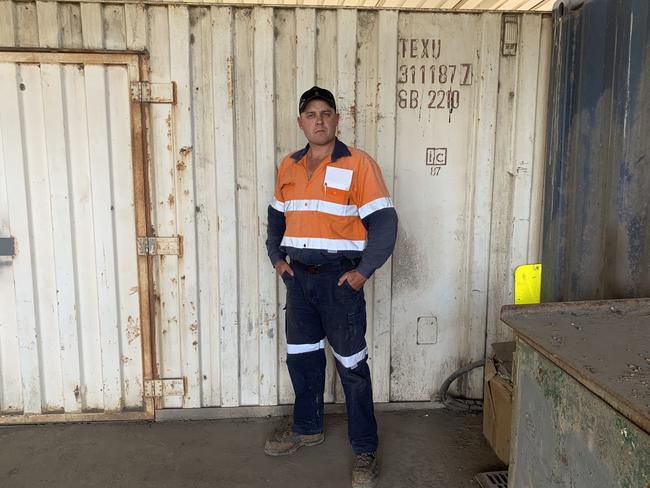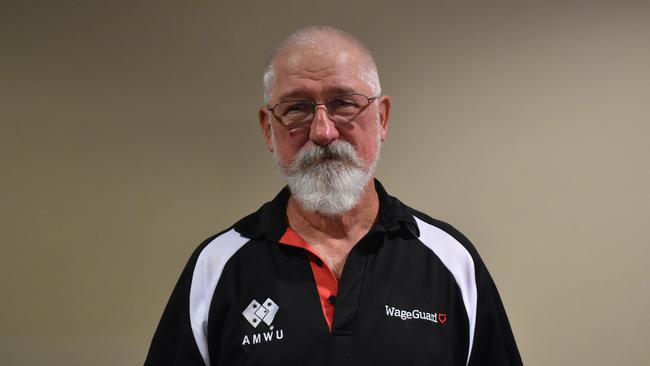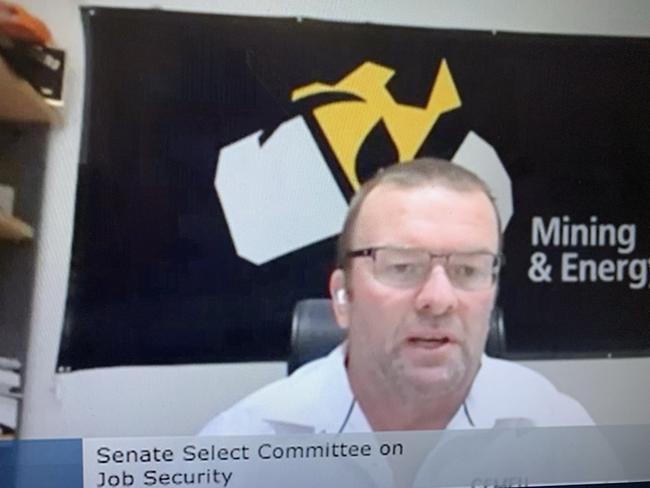Miner tells Senators casual employees now outnumber full-time employees two to one
Permanent miner says he earns at least $20k more than his fellow casual workers but labour hire firm says some workers ask to be put on casual over permanent.

Mackay
Don't miss out on the headlines from Mackay. Followed categories will be added to My News.
Bowen Basin miner Wayne Goulevitch has told a Senate hearing into job security that casual employees now outnumbered full-time employees two to one.
He said labour hire employees at the mines were once used to supplement full-time employees on leave but suggested the practice now meant mines made bigger profits from paying workers less.
“I honestly believe the companies are grandfathering my positions out of the industry, and that they’re doing it in a nefarious way, in my opinion,” he said.
During a live-streamed hearing that was supposed to sit in Mackay before Covid restrictions interfered, Mr Goulevitch said he had been operating mining equipment in Central Queensland for a multinational mining corporation since 2010.
“I started out like everyone did in my day as a labour hire employee,” he said.
“I worked for nine months as a casual before getting a full-time gig.
“Back then pre-strip are made up of 40 full-time employees and about five labour hire workers.

“Labour hire were at the time being used as supplemental labour to backfill full-time employees away on holidays, off sick or on maternity leave.
“This is, I believe, justifiable and acceptable use of casual labour.
“Somewhere along the way, a decision or lack of decision meant that within 10 years labour hire had ballooned to about 120 workers, or full-time employees remained around 40.
“Clearly, when casuals outnumber full-time employees two to one, supplemental can no longer be used as a word to describe labour hire.
“My crew hasn’t had a full-time employee join our team in over seven years.
“That is why I need ‘same job same pay’ just as much as casuals in the industry.
“Without it, my pay and conditions have been given a sunset.
“In effect that means large multinationals get to reset pay and conditions whenever they choose.”
Mr Goulevitch said he had not personally seen pay slips from labour hire employees but he knew from chats in the camps that he was on “at least $20,000 more than some of the labour hire people I’m working with”.
“The numbers are astronomically outweighed … so 50-50 is being generous,” he said.
Rockhampton miner Chad Stokes said he had worked in the coal mining industry for a decade as a pump crew operator.
He said for the past seven years, he had been a casual labour hire worker at a Central Queensland coal mine.

“There just aren’t any permanent jobs being offered anymore,” he said.
“I work the same roster and shifts as the permanent workers on my crew.
“I have no job security, I get paid less, and it’s really hard to take time off.
“I want to see the same job, same pay implemented for labour hire workers.
“Most importantly I think the mine operators should directly employ more workers.
“When you are labour hire, you are treated like a second class citizen; you are given the worst jobs and you could be let go at any time.
“At my coal mine, more than half the workers are employed through labour hire, rather than directly employed.
“Mining companies keep changing labour hire companies so that workers don’t get an opportunity to organise and improve their position.”
Fellow Central Queensland miner Rob Foot told the Senate hearing he was working in the Central Queensland mines under permanent working conditions for United Group Resources when he faced changing conditions.
“I worked for the firm for 14 years and one day the mines came along and said everyone on site had to go and work for WorkPac,” he told the committee.
“Now these people wanted to reduce my wages by half, and on a casual basis.

“You had to pay for your own inductions, you had to pay for your own medicals, you had to pay for accommodation, you had to pay training courses, safety training, certificates, courses, train tickets, etc, whereas all that in the past was supplied by the previous employer.
“As a consequence, they wanted everyone to be casual; no holiday pay, no sick pay, a flat rate of pay- no overtime, no travel pay, and if it rained, forklift operators had to sit in the smoko room with no pay.”
Labour hire company One Key Resources says market appetite drives pay rates for employees, with regional director Ben Lewis saying if they did not offer an attractive package, the company would not be able to attract or retain those skills.
“We operate over 60 different sites. Our rates of pay are, on average, including all engagement types, over $120,000,” he said.
“If we weren’t paying good wages, we’d lose good workers.
“We don’t aim for a disparity in rates, and I can’t comment on a disparity if there is one.”
Of the company’s 900 employees, Mr Lewis said 53 per cent were casual, 37 per cent were on fixed-term contracts and 10 per cent had permanent ongoing employment.
“Forty-seven per cent on stable contracts in total. The preference for casual contracts is due to the casual loading, and the mining industry banks on keeping jobs and staying in jobs on higher rates of pay,” he said
Mr Lewis said he could not explain the pay difference between labour hire and direct mine employees.
“If there is a difference, I don’t know the value of the difference,” he said.
“I haven’t worked direct for a mine. It varies also for different commodities and mine locations.”
Western Australia Senator Ben Small asked how many casuals had converted to permanent employees and was told less than 1 per cent of One Key’s workforce.
Mr Lewis said the company had never denied a request to become permanent and had the same number of requests “the other way”.
He denied there were threats or retribution for casual employees who spoke up on safety matters in the coal mining sector.
“From my experience, that’s not the case. We reward and recognise people who speak up,” he said.
When asked about how One Key Resources’ safety and injury statistics stacked up to best practice benchmarks, Mr Lewis said they were comparable with no marked difference.
“If we weren’t able to maintain a safety standard, that would affect our insurance rates, which isn’t the case,” he said.
“We’re committed to safety – we’ve had unfortunate incidents and that’s concerning to us, however we’re always supportive of any person who may be injured and we work to improve conditions with our clients and across the industry.
CFMEU Queensland’s mining and energy chief Stephen Smyth, a third generation coal miner with 33 years in the sector, said he believed the rate of casual workers might be higher than 50 per cent.
“We’re aware of some mines that have tight labour hire employment of over 450 employees at a mine and the only permanent people there are people in senior management,” he said

“We rely on what we see on the ground … the stories from our members, from non-members and workers in general.
“So I’m unsure as to why the Australian minerals council got their numbers wrong, but certainly on the ground, the percentage is certainly increasing.”
The CFMEU submission suggested about 50 per cent of mine employees were labour hire while the Mineral Council of Australia suggested it was about 16 per cent.
The Minerals Council of Australia, in its submission, said only 1 per cent of non-managerial workers in mining depended on an award for their wages and conditions.
Mr Smyth was asked if the industry was so unattractive, so precarious and so undesirable, why do thousands of people flock to join.
“Opportunities and the carrot at the end of it of getting a permanent shirt, as people like Chad can probably speak better than me,” he said.
“But there’s the opportunity to get in the industry. And secondly, obviously it’s an income for them and their families as a stepping stone to a permanent job.
“I call it the carrot being dangled at the end of the line. And that’s why a lot of labour hire people take the opportunities to come into the industry.”

Referring to evidence from the CFMEU suggesting as few as 50 per cent of the mining industry was directly employed, committee chair Tony Sheldon asked Hays Recruiting’s Nick Deligiannis if they would bid the price of an enterprise agreement that existed or would the company talk to the union.
“I can’t comment on anyone else’s process. We pay our temps the award, and if there’s an EA we charge the EA plus our margin,” the head of recruiting said.
Mr Deligiannis said the company had one enterprise agreement in place for black coal in the Bowen Basin but had zero workers after a contract lapsed.
He said he was not specifically aware of an agreement in 2018 at Saraji mine in the Bowen Basin where the level 1 pay rate of $30.14 per hour conflicted with the lowest rate of pay under the BMA agreement direct mine hires at $41.
“That’s a 39 per cent difference,” Mr Sheldon said, suggesting there was a lower rate under Hays’ EBA than under the mining company.
“Can’t tell you, because our EBA have been agreed to by workers, unions, and ourselves. That’s all I can say,” Mr Deligiannis said.
The CFMEU paid for research from the McKell Institute’s Dr Stephen Whelan which was published as ‘Wage-cutting Strategies in the Mining Industry: the cost to workers and communities’.
Based on a $35,000 wage difference between casual and permanent workers, Dr Whelan told the committee he estimated the direct and indirect economic cost of casualisation was between $400 million and $800 million.
Dr Whelan said this meant less money spent in coffee shops and hardware stores for nearby mining communities.

“With less expenditure in the community, there’s less income which is passed on to those industries, services, those businesses … because the miners are being paid lower wages,” he said.
“So the real challenge is not just understanding that first round effect, the direct loss of income for the mining workers, but the impact as it flows through the community.”
But when asked whether the casualisation was a deliberate attempt from mining companies to sidestep union pay rates, Dr Whelan said all businesses tried to minimise costs and this would be one way to do it.
The Moranbah hearing, that was scheduled for Monday, has been wrapped into what would have been a Brisbane hearing on Wednesday.
The day will begin with witnesses from a mining industry panel, Minerals Council of Australia, Anglo American, BHP and Rio Tinto.
Isaac Regional Council and Moranbah businesses and local organisations are expected to speak after lunch.




